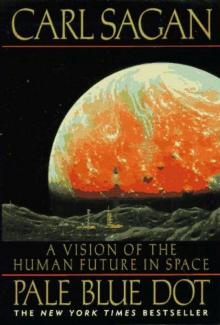- Home
- Carl Sagan
Broca's Brain Page 14
Broca's Brain Read online
Page 14
Even stranger are Velikovsky’s views on extraterrestrial life. He believes that much of the “Vermin,” and particularly the flies referred to in Exodus, really fell from his comet—although he hedges on the extraterrestrial origin of frogs while approvingly quoting from the Iranian text, the Bundahis (page 183), which seems to admit a rain of cosmic frogs. Let us consider flies only. Shall we expect houseflies or Drosophila melanogaster in forthcoming explorations of the clouds of Venus and Jupiter? He is quite explicit: “Venus—and therefore also Jupiter—is populated by vermin” (page 369). Will Velikovsky’s hypothesis fall if no flies are found?
The idea that, of all the organisms on Earth, flies alone are of extraterrestrial origin is curiously reminiscent of Martin Luther’s exasperated conclusion that, while the rest of life was created by God, the fly must have been created by the Devil because there is no conceivable practical use for it. But flies are perfectly respectable insects, closely related in anatomy, physiology and biochemistry to the other insecta. The possibility that 4.6 billion years of independent evolution on Jupiter—even if it were physically identical to the Earth—would produce a creature indistinguishable from other terrestrial organisms is to misread seriously the evolutionary process. Flies have the same enzymes, the same nucleic acids and even the same genetic code (which translates nucleic acid information into protein information) as do all the other organisms on Earth. There are too many intimate associations and identities between flies and other terrestrial organisms for them to have separate origins, as any serious investigation clearly shows.
In Exodus, Chapter 9, it is said that the cattle of Egypt all died, but of the cattle of the Children of Israel there “died not one.” In the same chapter we find a plague that affects flax and barley but not wheat and rye. This fine-tuned host-parasite specificity is very strange for cometary vermin with no prior biological contact with Earth, but is readily explicable in terms of home-grown terrestrial vermin.
Then there is the curious fact that flies metabolize molecular oxygen. There is no molecular oxygen on Jupiter, nor can there be, because oxygen is thermodynamically unstable in an excess of hydrogen. Are we to imagine that the entire terminal electron transfer apparatus required for life to deal with molecular oxygen was adventitiously evolved on Jupiter by Jovian organisms hoping someday to be transported to Earth? This would be yet a bigger miracle than Velikovsky’s principal collisional thesis. Velikovsky makes (page 187) a lame aside on the “ability of many small insects … to live in an atmosphere devoid of oxygen,” which misses the point. The question is how an organism evolved on Jupiter could live in and metabolize an atmosphere rich in oxygen.
Next there is the problem of fly ablation. Small flies have just the same mass and dimensions as small meteors, which are burned up at an altitude of about 100 kilometers when they enter the Earth’s atmosphere on cometary trajectories. Ablation accounts for the visibility of such meteors. Not only would cometary vermin be transformed rapidly into fried flies on entrance into the Earth’s atmosphere; they would, as cometary meteors are today, be vaporized into atoms and never “swarm” over Egypt to the consternation of the Pharaoh. Likewise, the temperatures attendant to ejection of the comet from Jupiter, referred to above, would fry Velikovsky’s flies. Impossible to begin with, doubly fried and atomized, cometary flies do not well survive critical scrutiny.
Finally, there is a curious reference to intelligent extraterrestrial life in Worlds in Collision. On page 364 Velikovsky argues that the near-collisions of Mars with Earth and Venus “make it highly improbable that any higher forms of life, if they previously existed there, survived on Mars.” But when we examine the Mars as seen by Mariner 9 and Viking 1 and 2, we find that something over one-third of the planet has a modified cratered terrain somewhat reminiscent of the Moon and displays no sign of spectacular catastrophes other than ancient impacts. The other half to two-thirds of the planet shows almost no sign whatever of such impacts, but instead displays dramatic evidence of major tectonic activity, lava flows and vulcanism about a billion years ago. The small but detectable amount of impact cratering in this terrain shows that it was made much longer than several thousand years ago. There is no way to reconcile this picture with a view of a planet recently so devastated by impact catastrophism that all intelligent life would thereby have been eliminated. It is also by no means clear why, if all life on Mars were to be exterminated in such encounters, all life on Earth was not similarly exterminated.
PROBLEM VI
MANNA
MANNA, according to the etymology in Exodus, derives from the Hebrew words man-hu, which means “What is it?” Indeed, an excellent question! The idea of food falling from comets is not absolutely straightforward. Optical spectroscopy of comet tails, even before Worlds in Collision was published (1950), showed the presence of simple fragments of hydrocarbons, but no aldehydes—the building blocks of carbohydrates—were known then. They may nevertheless be present in comets. However, from the passage of Comet Kohoutek near the Earth, it is now known that comets contain large quantities of simple nitriles—in particular, hydrogen cyanide and methyl cyanide. These are poisons, and it is not immediately obvious that comets are good to eat.
But let us put this objection aside, grant Velikovsky his hypothesis, and calculate the consequences. How much manna is required to feed the hundreds of thousands of Children of Israel for forty years (see Exodus, Chapter 16, Verse 35)?
In Exodus, Chapter 16, Verse 20, we find that the manna left overnight was infested by worms in the morning—an event possible with carbohydrates but extremely unlikely with hydrocarbons. Moses may have been a better chemist than Velikovsky. This event also shows that manna was not storable. It fell every day for forty years according to the Biblical account. We will assume that the quantity that fell every day was just sufficient to feed the Children of Israel, although Velikovsky assures us (page 138) from Midrashic sources that the quantity that fell was adequate for two thousand years rather than a mere forty. Let us assume that each Israelite ate on the order of a third of a kilogram of manna per day, somewhat less than a subsistence diet. Then each will eat 100 kilograms per year and 4,000 kilograms in forty years. Hundreds of thousands of Israelites, the number explicitly mentioned in Exodus, will then consume something over a million kilograms of manna during the forty years’ wandering in the desert. But we cannot imagine the debris from the cometary tail falling each day,* preferentially on the portion of the Wilderness of Sin in which the Israelites happened to have wandered. This would be no less miraculous than the Biblical account taken at face value. The area occupied by a few hundred thousand itinerant tribesmen, wandering under a common leadership, is, very roughly, several times 10−7 the area of the Earth. Therefore, during the forty years of wandering, all of the Earth must have accumulated several times 1018 grams of manna, or enough to cover the entire surface of the planet with manna to a depth of about an inch. If this indeed happened, it would certainly be a memorable event, and may even account for the gingerbread house in “Hansel and Gretel.”
Now, there is no reason for the manna to have fallen only on Earth. In forty years the tail of the comet, if restricted to the inner solar system, would have traversed some 1010 km. Making only a modest allowance for the ratio of the volume of the Earth to the volume of the tail, we find that the mass of manna distributed to the inner solar system by this event is larger than 1028 grams. This is not only more massive by many orders of magnitude than the most massive comet known; it is already more massive than the planet Venus. But comets cannot be composed only of manna. (Indeed, no manna at all has been detected so far in comets.) Comets are known to be composed primarily of ices, and a conservative estimate of the ratio of the mass of the comet to the mass of the manna is much larger than 103. Therefore, the mass of the comet must be much larger than 1031 grams. This is the mass of Jupiter. If we were to accept Velikovsky’s Midrashic source above, we would deduce that the comet had a mass comparable to that of the S
un. Interplanetary space in the inner solar system should even today be filled with manna. I leave it to the reader to make his own judgment on the validity of Velikovsky’s hypothesis in the light of such calculations.
PROBLEM VII
THE CLOUDS OF VENUS
VELIKOVSKY’S prognostication that the clouds of Venus were made of hydrocarbons or carbohydrates has many times been hailed as an example of a successful scientific prediction. From Velikovsky’s general thesis and the calculations just described above, it is clear that Venus should be saturated with manna, a carbohydrate. Velikovsky says (page x) that “the presence of hydrocarbon gases and dust in the cloud envelope of Venus would constitute a crucial test” for his ideas. It is also not clear whether “dust” in the foregoing quotation refers to hydrocarbon dust or just ordinary silicate dust. On the same page Velikovsky quotes himself as saying, “On the basis of this research, I assume that Venus must be rich in petroleum gases,” which seems to be an unambiguous reference to the components of natural gas, such as methane, ethane, ethylene and acetylene.
At this point, a little history must enter our story. In the 1930s and early 1940s, the only astronomer in the world concerning himself with planetary chemistry was the late Rupert Wildt, once of Göttingen, and later at Yale. It was Wildt who first identified methane in the atmospheres of Jupiter and Saturn, and it was he who first proposed the presence of higher hydrocarbon gases in the atmospheres of these planets. Thus, the idea that “petroleum gases” might exist on Jupiter is not original with Velikovsky. Likewise, it was Wildt who proposed that formaldehyde might be a constituent of the atmosphere of Venus, and that a carbohydrate polymer of formaldehyde might constitute the clouds. The idea of carbohydrates in the clouds of Venus was not original with Velikovsky either, and it is difficult to believe that one who so thoroughly researched the astronomical literature of the 1930s and 1940s was unaware of these papers by Wildt which relate so closely to Velikovsky’s central theme. Yet there is no mention whatever of the Jupiter phase of Wildt’s work and only a footnote on formaldehyde (page 368), without references, and without any acknowledgment that Wildt had proposed carbohydrates on Venus. Wildt, unlike Velikovsky, understood well the difference between hydrocarbons and carbohydrates; moreover, he performed unsuccessful spectroscopic searches in the near-ultraviolet for the proposed formaldehyde monomer. Being unable to find the monomer, he abandoned the hypothesis in 1942. Velikovsky did not.
As I pointed out many years ago (Sagan, 1961), the vapor pressure of simple hydrocarbons in the vicinity of the clouds of Venus should make them detectable if they comprise the clouds. They were not detectable then, and in the intervening years, despite a wide range of analytic techniques used, neither hydrocarbons nor carbohydrates have been found. These molecules have been searched for by high-resolution ground-based optical spectroscopy, including Fourier transform techniques; by ultraviolet spectroscopy from the Wisconsin Experimental Package of the Orbiting Astronomical Observatory OAO-2; by ground-based infrared observations; and by direct entry probes of the Soviet Union and the United States. Not one of them has been found. Typical abundance upper limits on the simplest hydrocarbons and on aldehydes, the building blocks of carbohydrates, are a few parts per million (Connes, et al., 1967; Owen and Sagan, 1972). [The corresponding upper limits for Mars are also a few parts per million (Owen and Sagan, 1972)]. All observations are consistent in showing that the bulk of the Venus atmosphere is composed of carbon dioxide. Indeed, because the carbon is present in such an oxidized form, at best trace constituents of the simple reduced hydrocarbons could be expected. Observations on the wings of the critical 3.5 micron region show not the slightest trace of the C-H absorption feature common to both hydrocarbons and carbohydrates (Pollack, et al., 1974). All other absorption bands in the Venus spectrum, from the ultraviolet through the infrared, are now understood; none of them is due to hydrocarbons or carbohydrates. No specific organic molecule has ever been suggested that can explain with precision the infrared spectrum of Venus as it is now known.
Moreover, the question of the composition of the Venus clouds—a major enigma for centuries—was solved not long ago (Young and Young, 1973; Sill, 1972; Young, 1973; Pollack, et al., 1974). The clouds of Venus are composed of an approximately 75 percent solution of sulfuric acid. This identification is consistent with the chemistry of the Venus atmosphere, in which hydrofluoric and hydrochloric acid have also been found; with the real part of the refractive index, deduced from polarimetry, which is known to three significant figures (1.44); with the 11.2 micron and 3 micron (and, now, far-infrared) absorption features; and with the discontinuity in the abundance of water vapor above and below the clouds. These observed features are inconsistent with the hypothesis of hydrocarbon or carbohydrate clouds.
With such organic clouds now so thoroughly discredited, why do we hear about space-vehicle research having corroborated Velikovsky’s thesis? This also requires a story. On December 14, 1962, the first successful American interplanetary spacecraft, Mariner 2, flew by Venus. Built by the Jet Propulsion Laboratory, it carried, among other more important instruments, an infrared radiometer for which I happened to be one of four experimenters. This was at a time before even the first successful lunar Ranger spacecraft, and NASA was comparatively inexperienced in releasing the scientific findings. A press conference was held in Washington to announce the results, and Dr. L. D. Kaplan, one of the experimenters on our team, was delegated to describe the results to the assembled reporters. It is clear that when his time came, he described the results with somewhat the following flavor (these are not his exact words): “Our experiment was a two-channel infrared radiometer, one channel centered in the 10.4 micron CO2 hot band, the other in an 8.4 micron clear window in the gas phase of the Venus atmosphere. The objective was to measure absolute brightness temperatures and differential transmission between the two channels. A limb-darkening law was found in which the normalized intensity varied as mu to the power alpha, where mu is the arccosine of the angle between the local planetary normal and the line of sight, and—”
At some such point he was interrupted by impatient reporters, unused to the intricacies of science, who said something like “Don’t tell us the dull stuff; give us the real poop! How thick are the clouds, how high are they, and what are they made of?” Kaplan replied, quite properly, that the infrared radiometer experiment was not designed to test such questions, nor did it. But then he said something like “I’ll tell you what I think.” He went on to describe his view that the greenhouse effect, in which an atmosphere is transparent to visible sunlight but opaque to infrared emission from the surface, needed to keep the surface of Venus hot, might not work on Venus because the atmospheric constituents seemed to be transparent at a wavelength in the vicinity of 3.5 microns. If some absorber at this wavelength existed in the Venus atmosphere, the window could be plugged, the greenhouse effect retained, and the high surface temperature accounted for. He proposed that hydrocarbons would be splendid greenhouse molecules.
Kaplan’s cautions were not noted by the press, and the next day headlines could be found in many American newspapers saying: “Hydrocarbon Clouds Found on Venus by Mariner 2.” Meanwhile, back at the Jet Propulsion Laboratory, several Laboratory publicists were in the process of writing a popular report on the mission, since called “Mariner: Mission to Venus.” One imagines them in the midst of writing, picking up the morning newspaper and saying, “Hey! I didn’t know we found hydrocarbon clouds on Venus.” And, indeed, that publication lists hydrocarbon clouds as one of the principal discoveries of Mariner 2: “At their base, the clouds are about 200 degrees F and probably are comprised of condensed hydrocarbons held in oily suspension.” (The report also opts for greenhouse heating of the Venus surface, but Velikovsky has chosen to believe only a part of what was printed.)
One now imagines the Administrator of NASA passing on the good tidings to the President in the annual report of the Space Administration; the President handing it
on yet another step in his annual report to Congress; and the writers of elementary astronomy texts, always anxious to include the very latest results, enshrining this “finding” in their pages. With so many apparently reliable, high-level and mutually consistent reports that Mariner 2 found hydrocarbon clouds on Venus, it is no wonder that Velikovsky and several fair-minded scientists, inexperienced in the mysterious ways of NASA, might deduce that here is the classic test of a scientific theory: an apparently bizarre prediction, made before the observation, and then unexpectedly confirmed by experiment.
The true situation is very different, as we have seen. Neither Mariner 2 nor any subsequent investigation of the Venus atmosphere has found evidence for hydrocarbons or carbohydrates, in gas, liquid or solid phase. It is now known (Pollack, 1969) that carbon dioxide and water vapor adequately fill the 3.5 micron window. The Pioneer Venus mission in late 1978 found just the water vapor needed, along with the long-observed quantity of carbon dioxide, to account for the high surface temperature through the greenhouse effect. It is ironic that the Mariner 2 “argument” for hydrocarbon clouds on Venus in fact derives from an attempt to rescue the greenhouse explanation of the high surface temperature, which Velikovsky does not support. It is also ironic that Professor Kaplan was later a co-author of a paper that established a very low abundance of methane, a “petroleum gas,” in a spectroscopic examination of the Venus atmosphere (Connes, et al., 1967).

 Cosmos
Cosmos Murmurs of Earth
Murmurs of Earth Broca's Brain
Broca's Brain Comet
Comet Contact
Contact Dragons of Eden
Dragons of Eden Cosmic Connection
Cosmic Connection Shadows of Forgotten Ancestors
Shadows of Forgotten Ancestors Billions & Billions
Billions & Billions Comet, Revised
Comet, Revised Broca's Brain: The Romance of Science
Broca's Brain: The Romance of Science The Varieties of Scientific Experience: A Personal View of the Search for God
The Varieties of Scientific Experience: A Personal View of the Search for God The Cosmic Connection
The Cosmic Connection Pale Blue Dot: A Vision of the Human Future in Space
Pale Blue Dot: A Vision of the Human Future in Space The Dragons of Eden
The Dragons of Eden